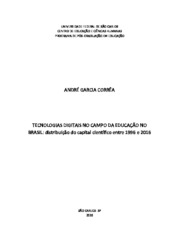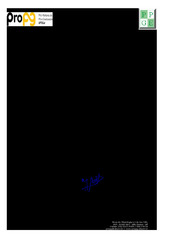Mostrar el registro sencillo del ítem
Tecnologias digitais no campo da educação no Brasil: distribuição do capital científico entre 1996 e 2016
| dc.contributor.author | Corrêa, André Garcia | |
| dc.date.accessioned | 2020-06-17T20:29:09Z | |
| dc.date.available | 2020-06-17T20:29:09Z | |
| dc.date.issued | 2020-02-04 | |
| dc.identifier.citation | CORRÊA, André Garcia. Tecnologias digitais no campo da educação no Brasil: distribuição do capital científico entre 1996 e 2016. 2020. Tese (Doutorado em Educação) – Universidade Federal de São Carlos, São Carlos, 2020. Disponível em: https://repositorio.ufscar.br/handle/ufscar/12910. | * |
| dc.identifier.uri | https://repositorio.ufscar.br/handle/ufscar/12910 | |
| dc.description.abstract | This is the report of a doctoral research that investigated the phenomenon of the distribution of scientific capital on several fronts in researches about Digital Information and Communication Technologies (DTIC) within the field of Education. The investigation used bibliometric and scientometric quantitative data that were analyzed under theoretical references of sociology of science, considering the scientific practice as belonging to agents of a social field, under the historical context of research in Education throughout the 20th century and the social aspects of postmodernity. In addition to analyzing the data, the investigation also tested theoretical statements about the field and its production with empirical analyses, seeking to falsify them. The data are of two different natures: a) metadata of theses produced in Post-Graduate Education Programs in Brazil with grades 5 and higher, between the years 1996 and 2016, compiled in the database built by the Grupo Horizonte of the Federal University of São Carlos (UFSCar) and; b) bibliometric data referring to the citations from a sample among the cataloged research theses on Education and DTIC in the State of Sao Paulo, this time extending between 1996 and 2008. This text also brings a discussion on epistemology and sociology of science, taking a position on Kant's Transcendental Idealism, Popper's Critical Deductivism, Dialectical Historical Materialism and the concept of Technology, according to the arguments of Álvaro Vieira Pinto and Pierre Lévy. The data were analyzed mainly under the theoretical lens of Bourdieu's theses for sociology of science about the scientific field and its symbolic capital. Also considered for analysis are the effects of postmodernity on scientific production and the concepts of Zygmunt Bauman of Ambivalence in Modernity and Liquid Modernity. The investigation shows, in general, a very fragmented field that has grown considerably in the observed time window, but which at various times presents a concentration of symbolic capital. When looking at the investigated objects and the citations used, in both the fragmentation is observable in many nodes of the network with a concentrated nucleus of scientific capital. When the empirical analysis of the Social Hierarchy of Objects was made, the network found was very large, but with very low density. However, there is a clear hierarchy between the themes with a core that focuses on the teacher and his/her education. DTIC also appear at the center of the nucleus, demonstrating that despite being only recent developed, they have quickly become a source of scientific capital for education researchers. The claim, seen in the theoretical framework on the history of research in Education, that the field has lost its object in postmodernity, has therefore been refuted. We also tried to test statements from the theoretical framework of the historical context of scientific production in Education in Brazil that the dialectical historical materialist method has fallen into disuse. In fact, the data showed an increase in works using this method at almost the same rate as the growth of the field itself, as well as an intimate relationship between Marxist works and objects with more scientific capital. A possible inflation of scientific capital within the field or a productivism between 1996 and 2008 were not evident. There were no changes in the average life of citations. The field seems to have grown to an extent that absorbed the increase in production in absolute numbers. As with objects, references are also scattered but show a concentration of symbolic capital around a great orthodoxy. Names like José Armando Valente, Paulo Freire and Pierre Lévy are the authors with the highest rates of symbolic capital. In a broader sense, research has shown that it is possible to use bibliometrics for a sociological analysis of scientific fields, combining quantitative data with qualitative analysis as well as empirically observing Pierre Bourdieu's theoretical concepts. | eng |
| dc.description.sponsorship | Não recebi financiamento | por |
| dc.language.iso | por | por |
| dc.publisher | Universidade Federal de São Carlos | por |
| dc.rights | Attribution-NonCommercial-NoDerivs 3.0 Brazil | * |
| dc.rights.uri | http://creativecommons.org/licenses/by-nc-nd/3.0/br/ | * |
| dc.subject | Educação | por |
| dc.subject | Tecnologias Digitais de Informação e Comunicação (TDIC) | por |
| dc.subject | Sociologia da ciência | por |
| dc.subject | Teoria do conhecimento | por |
| dc.subject | Bibliometria | por |
| dc.subject | Education | eng |
| dc.subject | Digital Information and Communication Technologies | eng |
| dc.subject | Sociology of science | eng |
| dc.subject | Knowledge theory | eng |
| dc.subject | Bibliometrics | eng |
| dc.title | Tecnologias digitais no campo da educação no Brasil: distribuição do capital científico entre 1996 e 2016 | por |
| dc.title.alternative | Digital technologies in the field of education in Brazil: distribution of scientific capital between 1996 and 2016 | eng |
| dc.type | Tese | por |
| dc.contributor.advisor1 | Mill, Daniel Ribeiro Silva | |
| dc.contributor.advisor1Lattes | http://lattes.cnpq.br/1515286597269486 | por |
| dc.description.resumo | Este é relatório de uma pesquisa de doutorado que investigou o fenômeno da distribuição de capital científico em diversas frentes em pesquisas sobre Tecnologias Digitais de Informação e Comunicação (TDIC) dentro do campo de Educação. A investigação utilizou de dados quantitativos bibliométricos e cientométricos que foram analisados sob referenciais teóricos de sociologia da ciência, entendendo o fazer científico como pertencendo a agentes de um campo social, sob o contexto histórico da pesquisa em Educação ao longo do Séc. XX e as relações sociais da pós-modernidade. Além da análise dos dados, a investigação também testou afirmações teóricas sobre o campo e sua produção com análises empíricas procurando falseá-las. Os dados são de duas naturezas distintas: a) metadados de teses defendidas em Programas de Pós-Graduação em Educação no Brasil com notas 5 e superior entre os anos de 1996 e 2016 compiladas em uma base de dados do Grupo Horizonte da Universidade Federal de São Carlos (UFSCar) e; b) dados bibliométricos referentes às citações utilizadas numa amostragem dentre as teses catalogadas de pesquisas sobre Educação e TDIC do Estado de SP, desta vez se estendendo entre os anos de 1996 e 2008. Este texto também traz uma discussão sobre epistemologia e sociologia da ciência, se posicionando a respeito do Idealismo Transcendental de Kant, o Dedutivismo Crítico de Popper, o Materialismo Histórico Dialético e o conceito de Tecnologia segundo argumentos de Álvaro Vieira Pinto e Pierre Lévy. Os dados são analisados principalmente sob as lentes teóricas das teses de Bourdieu para a sociologia da ciência sobre o campo científico e seu capital simbólico. Também são levadas em consideração para as análises os efeitos da pós-modernidade na produção científica e os conceitos de Zygmunt Bauman da Ambivalência na Modernidade e a Modernidade Líquida. A investigação mostra, de forma, geral, um campo muito fragmentado e que cresceu consideravelmente na janela temporal observada, mas que em vários momentos apresenta uma concentração de capital simbólico. Tanto quando se olham os objetos investigados quanto as citações utilizadas, é observável a fragmentação em muitos nós da rede com um núcleo concentrado de capital científico. Quando feita a análise empírica da Hierarquia Social dos Objetos, a rede encontrada é muito grande, mas com baixíssima densidade. No entanto, existe uma hierarquia clara entre os temas com um núcleo que foca no professor e sua formação. As TDIC também aparecem no centro do núcleo, demonstrando que, apesar de recentes, tornaram-se rapidamente uma fonte de capital científico aos investigadores da Educação. A afirmação vista no referencial teórico sobre a história da pesquisa em Educação de que o campo perdeu seu objeto na pós-modernidade foi, portanto, refutada. Também procurou-se testar afirmações do referencial teórico do contexto histórico da produção científica em Educação no Brasil de que o método materialista histórico dialético tenha caído em desuso. Na realidade, os dados mostraram um aumento de trabalhos que usam tal método quase na mesma proporção que o crescimento do próprio campo, bem como uma relação íntima de trabalhos marxistas com os objetos com mais capital científico. Não ficou evidente uma possível inflação do capital científico dentro do campo ou um produtivismo entre 1996 e 2008. Pois não houve alterações na vida média de citações. O campo parece ter crescido numa medida que absorveu o aumento da produção em números absolutos. Assim como aconteceu com os objetos, as referências também estão pulverizadas, mas mostram uma concentração de capital simbólico em torno de uma grande ortodoxia. Nomes como José Armando Valente, Paulo Freire e Pierre Lévy são aqueles com maiores índices de capital simbólico. Num sentido mais amplo, a investigação mostrou ser possível utilizar de bibliometria para uma análise sociológica de campos científicos, aliando dados quantitativos a análises qualitativas, bem como observou empiricamente conceitos teóricos de Pierre Bourdieu. | por |
| dc.publisher.initials | UFSCar | por |
| dc.publisher.program | Programa de Pós-Graduação em Educação - PPGE | por |
| dc.subject.cnpq | CIENCIAS HUMANAS::EDUCACAO::TOPICOS ESPECIFICOS DE EDUCACAO | por |
| dc.publisher.address | Câmpus São Carlos | por |
| dc.contributor.authorlattes | http://lattes.cnpq.br/6166163239013801 | por |


